Unit 4 My home 单元复习(三)-语法+典型例题(共26张PPT)
文档属性
| 名称 | Unit 4 My home 单元复习(三)-语法+典型例题(共26张PPT) |  | |
| 格式 | pptx | ||
| 文件大小 | 46.7MB | ||
| 资源类型 | 试卷 | ||
| 版本资源 | 人教版(PEP) | ||
| 科目 | 英语 | ||
| 更新时间 | 2024-08-12 11:27:22 | ||
图片预览



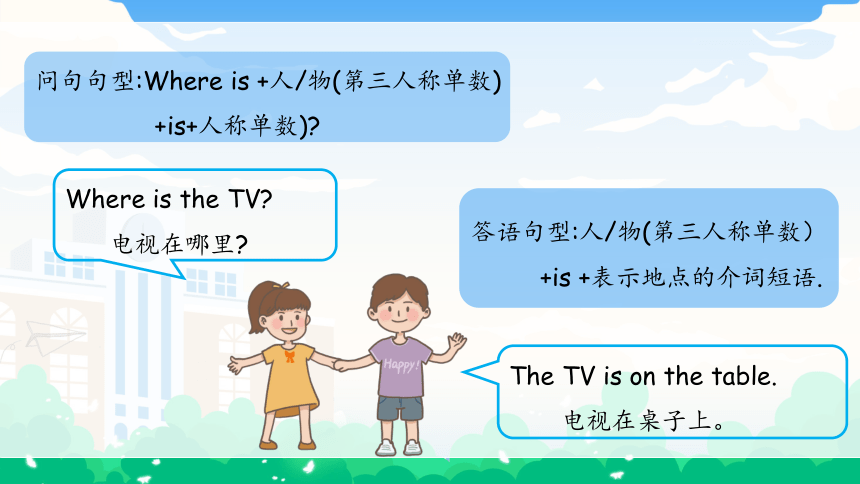
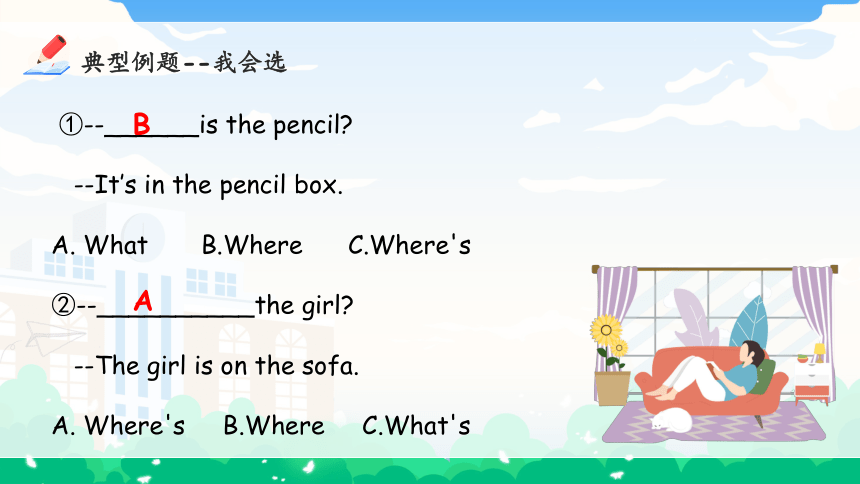
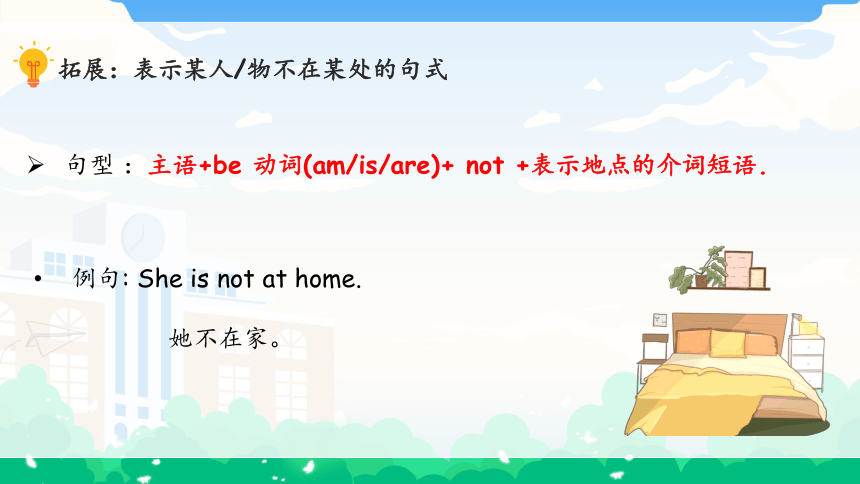
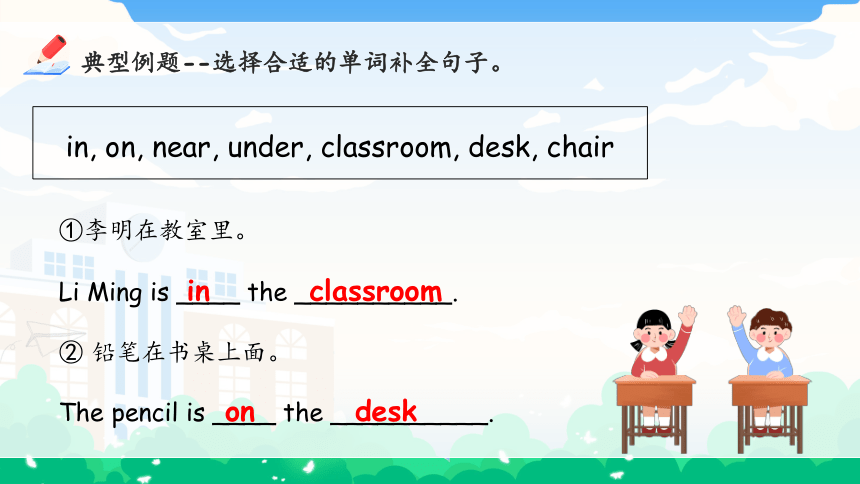
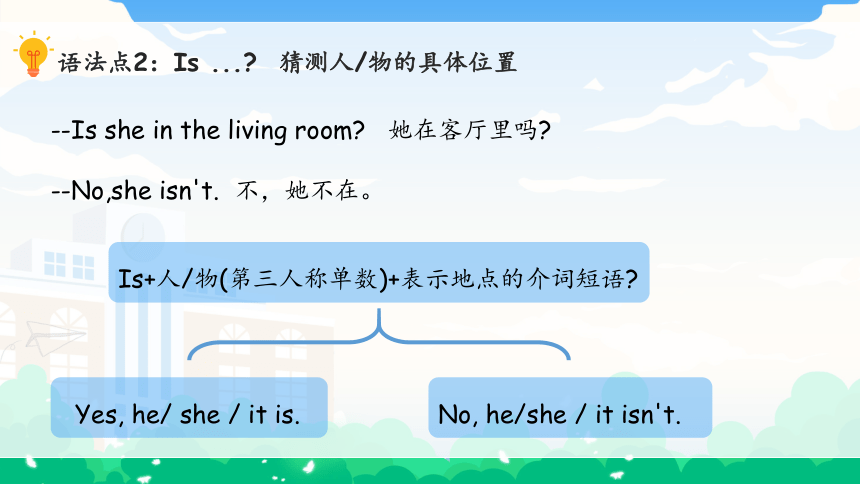
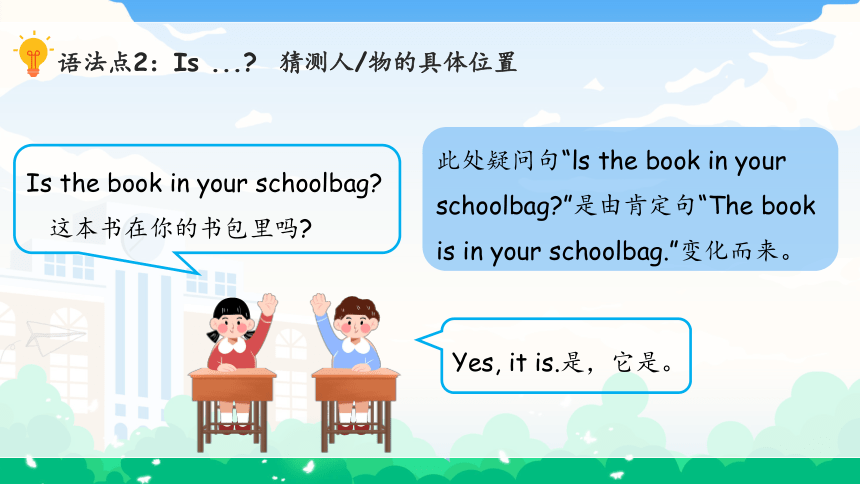
文档简介
(共26张PPT)
My home
Unit 4
主讲人: 老师
日期: 年 月
人教版四年级上册复习课件
语法过关
知识点讲解+对点练习
Part 3
--Where is he 她在哪里
--He's in the kitchen. 她在厨房里。
where /wea(r)/ adv.意为“在哪里”,常引导特殊疑问句,用来询问人或物的具体位置。
语法点1:Where is... 询问人/物品的位置
The TV is on the table.
电视在桌子上。
Where is the TV
电视在哪里
问句句型:Where is +人/物(第三人称单数)
+is+人称单数)
答语句型:人/物(第三人称单数) +is +表示地点的介词短语.
①--______is the pencil
--It’s in the pencil box.
A. What B.Where C.Where's
②--__________the girl
--The girl is on the sofa.
A. Where's B.Where C.What's
B
A
典型例题--我会选
例句: She is not at home.
她不在家。
句型 :主语+be 动词(am/is/are)+ not +表示地点的介词短语.
拓展:表示某人/物不在某处的句式
①李明在教室里。
Li Ming is ____ the __________.
② 铅笔在书桌上面。
The pencil is ____ the __________.
in classroom
on desk
典型例题--选择合适的单词补全句子。
in, on, near, under, classroom, desk, chair
--Is she in the living room 她在客厅里吗
--No,she isn't. 不,她不在。
语法点2:Is ... 猜测人/物的具体位置
Is+人/物(第三人称单数)+表示地点的介词短语
Yes, he/ she / it is.
No, he/she / it isn't.
语法点2:Is ... 猜测人/物的具体位置
Yes, it is.是,它是。
Is the book in your schoolbag
这本书在你的书包里吗
此处疑问句“ls the book in your schoolbag ”是由肯定句“The book is in your schoolbag.”变化而来。
拓展:肯定句变一般疑问句的基本变化规则
步骤
一提
Be动词提前
二改
三问号
am→are
I,we→you my,our→your
some→any
句尾+?
拓展:肯定句变一般疑问句的基本变化规则
陈述句:She is in the living room.
她在客厅里。
一般疑问句:Is she in the living room
她在客厅里吗
易错点提示:
含be动词的陈述句变一般疑问句时,有时主语和be动词也会发生变化。比如:“我”变“你”,“我的”变“你的”,“我们的”变“你们的”,am变are。
例句:This is my bag. 这是我的包。(陈述句)
Is this your bag 这是你的包吗 (一般疑问句)
①--Where is the dog Is it in the house
--____________________.
A. No, it isn't. B. No, it can't.
②看图片,选择正确的答语。
--Is the cat in the box
--____________________.
A. Yes, it is. B. No, it isn't.
典型例题--选择正确的答语。
A
A
① The books are in your bag.(改为一般疑问句)
_________________________________
②in, the, pen, my, pencil box, is (.) (连词成句)
_________________________________
③ I am happy today.(改为一般疑问句)
________________________________
典型例题--按要求完成下列句子。
Are the books in your bag
The pen is in the pencil box.
Are you happy today
祈使句是用来表达命令、请求、禁止等的句子,
它最显著的特点是:以动词原形开头。
语法点3:祈使句家族
Open the door, please.
请打开门。
祈使句根据其开头的引导词,常有以下几种类型:
语法点3:祈使句家族
名称 结构 例句
Do型 实义动词原形(+其他). Come in, please.请进。
Be型 Be +表语(+其他). Be quiet, please.请安静
Let 型 Let +宾语+动词原形(+其他). Let Bob go shopping.
让鲍勃去购物吧。
No型 No+动词的-ing 形式/ 名词 No fishing.禁止捕鱼。
① the, open, window(.)
_______________________
② school, go, let’s, to (.)
_______________________
典型例题--连词成句。
Open the window.
Let’s go to school.
Where are the keys 钥匙在哪里
语法点4:Where are ... 询问人/物品的位置重点
此句中 keys 是复数形式,所以be动词为相应的复数形式 are。此句型用来询问多个人/物品的具体位置。
They are under the desk.
它们在书桌下面。
Mum,Where are my crayons
妈妈,我的蜡笔在哪里?
问句句型:Where are+人/物(第三人称复数)?
答语句型:人/物(第三人称复数)+are+表示地点的介词短语。
易错点提示:
当主语是第三人称单数时,be动词用is;主语为第二人称或复数时,be动词用are。
例句: A book is on the desk. 一本书在书桌上。
Some crayons are on the desk. 一些蜡笔在书桌上。
They're in the door. 它们在门上。
语法点5:表述某些人或物所在位置
They're=They are
in the door 在门上
in the door意为“在门上”。汉语中我们常会说"钥匙在门上”。但英语中用的却是in,为什么 in意为"在……里面”。如果我们仔细思索,实际上钥匙是在门的锁眼里面,所以英语中用in就不难理解了。
They are in the box.
它们在盒子里。
Where are your toys
你的玩具在哪里
语法点5:表述某些人或物所在位置
① on, desk, the, are, they(.)
_________________________
②on, desk, the, are, they( )
__________________________
典型例题--连词成句。
They are on the desk.
Are they on the desk
--Are they on the table 它们在桌子上吗
--No, -they aren't. 不,它们不在。
语法点6:Are ... 猜测人/物的具体位置
该问句是由肯定句“They are on the table.”将 be 动词 are 提到句首变化而来的一般疑问句,用来猜测多个人或物的位置。
Yes, they are.
Are the books in your schoolbag
Are +人/物(第三人称复数)+表示地点的介词短语
肯定回答:
Yes, they are.
否定回答:
No, they aren't.
See You !
人教版四年级上册复习课件
My home
Unit 4
主讲人: 老师
日期: 年 月
人教版四年级上册复习课件
语法过关
知识点讲解+对点练习
Part 3
--Where is he 她在哪里
--He's in the kitchen. 她在厨房里。
where /wea(r)/ adv.意为“在哪里”,常引导特殊疑问句,用来询问人或物的具体位置。
语法点1:Where is... 询问人/物品的位置
The TV is on the table.
电视在桌子上。
Where is the TV
电视在哪里
问句句型:Where is +人/物(第三人称单数)
+is+人称单数)
答语句型:人/物(第三人称单数) +is +表示地点的介词短语.
①--______is the pencil
--It’s in the pencil box.
A. What B.Where C.Where's
②--__________the girl
--The girl is on the sofa.
A. Where's B.Where C.What's
B
A
典型例题--我会选
例句: She is not at home.
她不在家。
句型 :主语+be 动词(am/is/are)+ not +表示地点的介词短语.
拓展:表示某人/物不在某处的句式
①李明在教室里。
Li Ming is ____ the __________.
② 铅笔在书桌上面。
The pencil is ____ the __________.
in classroom
on desk
典型例题--选择合适的单词补全句子。
in, on, near, under, classroom, desk, chair
--Is she in the living room 她在客厅里吗
--No,she isn't. 不,她不在。
语法点2:Is ... 猜测人/物的具体位置
Is+人/物(第三人称单数)+表示地点的介词短语
Yes, he/ she / it is.
No, he/she / it isn't.
语法点2:Is ... 猜测人/物的具体位置
Yes, it is.是,它是。
Is the book in your schoolbag
这本书在你的书包里吗
此处疑问句“ls the book in your schoolbag ”是由肯定句“The book is in your schoolbag.”变化而来。
拓展:肯定句变一般疑问句的基本变化规则
步骤
一提
Be动词提前
二改
三问号
am→are
I,we→you my,our→your
some→any
句尾+?
拓展:肯定句变一般疑问句的基本变化规则
陈述句:She is in the living room.
她在客厅里。
一般疑问句:Is she in the living room
她在客厅里吗
易错点提示:
含be动词的陈述句变一般疑问句时,有时主语和be动词也会发生变化。比如:“我”变“你”,“我的”变“你的”,“我们的”变“你们的”,am变are。
例句:This is my bag. 这是我的包。(陈述句)
Is this your bag 这是你的包吗 (一般疑问句)
①--Where is the dog Is it in the house
--____________________.
A. No, it isn't. B. No, it can't.
②看图片,选择正确的答语。
--Is the cat in the box
--____________________.
A. Yes, it is. B. No, it isn't.
典型例题--选择正确的答语。
A
A
① The books are in your bag.(改为一般疑问句)
_________________________________
②in, the, pen, my, pencil box, is (.) (连词成句)
_________________________________
③ I am happy today.(改为一般疑问句)
________________________________
典型例题--按要求完成下列句子。
Are the books in your bag
The pen is in the pencil box.
Are you happy today
祈使句是用来表达命令、请求、禁止等的句子,
它最显著的特点是:以动词原形开头。
语法点3:祈使句家族
Open the door, please.
请打开门。
祈使句根据其开头的引导词,常有以下几种类型:
语法点3:祈使句家族
名称 结构 例句
Do型 实义动词原形(+其他). Come in, please.请进。
Be型 Be +表语(+其他). Be quiet, please.请安静
Let 型 Let +宾语+动词原形(+其他). Let Bob go shopping.
让鲍勃去购物吧。
No型 No+动词的-ing 形式/ 名词 No fishing.禁止捕鱼。
① the, open, window(.)
_______________________
② school, go, let’s, to (.)
_______________________
典型例题--连词成句。
Open the window.
Let’s go to school.
Where are the keys 钥匙在哪里
语法点4:Where are ... 询问人/物品的位置重点
此句中 keys 是复数形式,所以be动词为相应的复数形式 are。此句型用来询问多个人/物品的具体位置。
They are under the desk.
它们在书桌下面。
Mum,Where are my crayons
妈妈,我的蜡笔在哪里?
问句句型:Where are+人/物(第三人称复数)?
答语句型:人/物(第三人称复数)+are+表示地点的介词短语。
易错点提示:
当主语是第三人称单数时,be动词用is;主语为第二人称或复数时,be动词用are。
例句: A book is on the desk. 一本书在书桌上。
Some crayons are on the desk. 一些蜡笔在书桌上。
They're in the door. 它们在门上。
语法点5:表述某些人或物所在位置
They're=They are
in the door 在门上
in the door意为“在门上”。汉语中我们常会说"钥匙在门上”。但英语中用的却是in,为什么 in意为"在……里面”。如果我们仔细思索,实际上钥匙是在门的锁眼里面,所以英语中用in就不难理解了。
They are in the box.
它们在盒子里。
Where are your toys
你的玩具在哪里
语法点5:表述某些人或物所在位置
① on, desk, the, are, they(.)
_________________________
②on, desk, the, are, they( )
__________________________
典型例题--连词成句。
They are on the desk.
Are they on the desk
--Are they on the table 它们在桌子上吗
--No, -they aren't. 不,它们不在。
语法点6:Are ... 猜测人/物的具体位置
该问句是由肯定句“They are on the table.”将 be 动词 are 提到句首变化而来的一般疑问句,用来猜测多个人或物的位置。
Yes, they are.
Are the books in your schoolbag
Are +人/物(第三人称复数)+表示地点的介词短语
肯定回答:
Yes, they are.
否定回答:
No, they aren't.
See You !
人教版四年级上册复习课件
